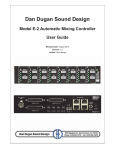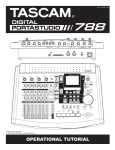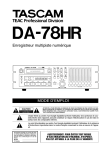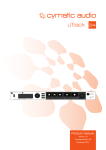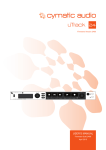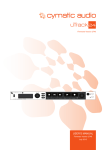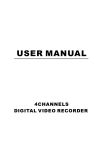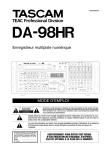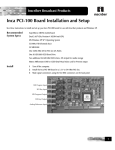Download Tascam DA-78HR User's Manual
Transcript
DA-78HR Technical Documentation PRODUCT OVERVIEW The DTRS format has long been respected as the most reliable format in digital recording, and now the DTRS format is leading the way into high resolution 24 bit recording. The DA-78HR works with 16 bit DTRS machines, using the same DTRS Sync line for sample accurate lock plus the ability to read and write the older 16 bit format. However, the DA-78HR offers the ability to write 8 tracks of 24 bit audio to tape in the HR format, built in SMPTE synchronization, MIDI ports for MTC and MMC, plus a built-in 8 channel digital mixer for internal bounces or monitor mix generation. • Records 8 tracks of 24 Bit Audio To Hi8 Tapes • Reads and Writes 16 and 24 Bit DTRS Tapes • 24 Bit A/D and D/A Converters • 16 Machine Sample Accurate Lock with DTRS Sync • >104dB Dynamic Range • Balanced DB25 & Unbalanced RCA Analog I/O • 108 Minutes of Record Time on 120 Hi8 Tape • TDIF Digital I/O & SPDIF Digital I/O • SMPTE Time Code Generation and Chasing • Word Sync In/Out/Thru • Generates MIDI Time Code • Track Slip from -200 to +7200 Samples • Responds to MIDI Machine Control • Built-In 8 Channel Digital Mixer APPLICATIONS SPECIFICATIONS The DA-78HR's high audio quality, long record time, rugged reliability, built-in time code capabilities, built-in MIDI capabilities, and affordable price combine into a product that can handle numerous situations. Personal and Project Studios Maximum features, minimum hassle. The DA-78HR brings DTRS tape into 24 bit audio, offering the very best sound quality available today. New features like built in MIDI ports and SMPTE synchronization gives you the ability to chase other tape machines (analog or digital), and the ability to work with sequencers and digital consoles. For the ultimate cost effective flexibility without having to locate additional accessories, the DA-78HR is the best digital tape machine for the market. Live Performance and Recording In live performance, there is no take 2. Whether you are using the DA-78HR to play some additional backing tracks or recording the performance live, you can count on the DA-78HR to get it right the first time. With 108 minutes of record time on a single tape, you can put a whole live song set on a single tape; no need to stop everything so you can switch tapes. Audio for Video on a Budget For anyone trying to make music for television or film, the DTRS format is the de-facto standard format for transfers and many stages of recording. The synchronization features will allow you to chase another audio machine, or a video deck. Again, the 108 minute record time was maintained for the new 24 bit recording mode, allowing 1 hour reels to be stored on a tape, along with reference tones and the independent subcode time code track. More advanced video applications will want a DA-98HR, which adds 9 pin control, blackburst resolve, and built in bit split for higher resolution audio recording. 7733 Telegraph Road • Montebello, CA 90640 • Specifications: Format: Recording Method: Tracking Method: Maximum Record Time: Time to Play from Stop: Shuttle Speeds: Varispeed: Subcode: SMPTE Frame Rates: Error Correction: DTRS and DTRS-HR Rotary Head / Helical Scan ATF (Automatic Track Finding) 108 min (using P6-120 tape) < 2 seconds 8x, 4x, 2x, 1x, 0.5x, 0.25x ±6% Independent ABS and SMPTE TC 30fps, 30dfps, 29.97fps, 29.97dfps, 25fps, 24fps Double-encoded Reed-Solomon code Frequency Response: Signal to Noise Ratio: Total Harmonic Distortion: Channel Separation: 20Hz-20kHz ±0.5dB >104dB (HR), >100dB (Standard) <0.004% (HR), <0.005% (Standard) >90dB @ 1kHz Sampling Frequency: Recording Resolution: Reference Level: Crossfade Time: Track Delay: Word Sync Source: A/D Converters: D/A Converters: 44.1kHz, 48kHz 16 bit, 24 bit -16dB (full bit) 10ms to 200ms (10ms increments) -200 to +7200 samples (set in samples or msec) Internal, Word, SPDIF 24 bit, 128x oversample (selectable dither) 24 bit, 128x oversample Analog Inputs: DB25, +4dBu, 20kOhm (8x) RCA, -10dBV, 10kOhm DB25, +4dBu, 10kOhm (8x) RCA, -10dBV, 250 Ohm TDIF-1 Format, RCA Coaxial SPDIF DTRS Sync DB15 RCA, 0.5Vp-p to 10Vp-p, 10kOhm RCA, 2Vp-p, 100kOhm Auto Terminating BNC, 75 Ohm (TTL) BNC, 75 Ohm In, Out, Thru 1/4" phono (For TASCAM RC-30P) Analog Outputs: Digital I/O: Remote/Sync: Time Code In: Time Code Out: Word Sync In/Thru: Word Sync Out: MIDI I/O Punch In Port: Dimensions: Weight: Power Requirements: 482x143x350mm, 19" x 5.6" x 13.8" 8.1kg, 17.8 lbs USA/Canada 120VAC, 60Hz UK/Europe 230VAC, 50Hz Australia 240VAC, 50Hz Power Consumption 34W Electromagnetic Environment: E4 (323) 726-0303 • http://www.tascam.com All features and specifications are subject to change without notice. Contact your local TASCAM representative for the latest information. Page 1 of 3 DA-78HR_TECHDOC.pdf 032500 DA-78HR Technical Documentation DTRS HISTORY Ever since the introduction of the DA-88 in 1992, users of all levels have been using DTRS machines to create, mix, and transfer their tracks at home and between studios. The DTRS standard has become renowned for top quality sound, top notch reliability, and the fastest transport and machine lock in the business. The DA-88 was originally intended for the music market, but since it was so full featured, it also found its way into major television and motion picture studios. The DTRS format has long been the standard format to move audio from one studio to the next, due to the affordable nature of the machine and media, as well as the high audio quality. In addition, a number of studios have been using DA-88s to expand their track count by having the DA-88 chase analog machines, or other digital formats. With the introduction of the DA-38 and DA-98 in 1996, the DTRS machines added some new features like a digital patchbay, test tone oscillators, and an even faster transport than the original DA-88. Still, the DA-88 had made such an indelible mark on the industry that it's production was continued by popular demand into the year 2000. The DA-78HR and DA-98HR are following in the footsteps of its heritage, continuing the traditions established and attested to over the years at a new standard - 24 bit. All in all, the DTRS machines give you the best sound, the most flexibility, and tried and true reliability that has been proven for almost a decade. TASCAM's DA-88, the original DTRS format recorder THE 24 BIT ACHIEVEMENT BACKWARDS COMPATIBILITY When the 24 bit DTRS format was announced, most users were curious about how we did it. 24 bit audio requires 50% more data than the original 16 bit format, yet the DA-78HR didn't cut back on tracks or record time. Many assumed that the 24 bit format would have been less reliable since more information is written in a smaller space. Well, actually the 24 bit format is even more reliable. Here's why: When the high resolution machines were designed, the ability to work with the original 16 bit machines like DA-38s, DA-88s, and DA-98s was a high priority. When digital information is written to tapes, it isn't like writing a bunch of ones and zeros on a piece of paper. All the data passes through an encoder and decoder (codec) when going to and coming from tape. The coding process utilizes a lossless algorithm allowing a larger amount of data to be stored in the same amount of space. The original DTRS format utilized a codec based on the 8-10 Modulation Principle used by most all DAT recorders. This format has been around for almost two decades; more efficient encoding schemes have been developed over time. High resolution DTRS machines utilizes the 1-7 RLL (Run Length Limited) codec commonly used in hard drive and DVD technologies. This format is 66% more space efficient than the codec used in the original DTRS machines. Since only 50% more data was needed to store the audio itself, the other 16% was dedicated to additional data verification beyond the original DTRS machine. So, the 24 bit DTRS machines do not reduce the print size. The write area is actually about the same size. The 24 bit machine utilizes a better codec which offers more efficient use of the space, as well as increased reliability through more accurate data verification processes. 7733 Telegraph Road • Montebello, CA 90640 • Sync Chain High resolution DTRS machines use the same DTRS Sync line that the previous machines used. So, you can lock any combination of 16 bit machines with 24 bit machines sample accurately in 2 seconds or less. Audio I/O The new high resolution DTRS machines use the same DB25 plugs for balanced audio, and TDIF lines for transfers and integration into digital studios. This means if you are trading out 16 bit machines for 24 bit machines, there are no new cabling requirements. Tape Format The DA-78HR can read and write 16 bit format tapes, allowing HR users to seamlessly work with owners of older DTRS machines. However, 24 bit tapes created on a high resolution DTRS machine will only work on other high resolution DTRS machines. Time Code Track In addition to the 8 tracks of audio, DTRS machines can handle two separate time tracks in subcode of the tape. One of the tracks is the tape's absolute time, and the other is an independent SMPTE time code track. The high resolution DTRS machines can read and write this SMPTE time code track in both 16 bit and 24 bit format, so you can continue working the same way you are used to working. (323) 726-0303 • http://www.tascam.com All features and specifications are subject to change without notice. Contact your local TASCAM representative for the latest information. Page 2 of 3 DA-78HR_TECHDOC.pdf 032500 DA-78HR Technical Documentation ANALOG DB25 PINOUT START-UP MESSAGE The analog DB25 pinout on the DA-78HR is the exact same as on the other DTRS machines. While these cables are readily available in your local retail outlets, the pinout is listed here for users wishing to make custom cables and snakes. The DA-78HR displays TASCAM HR across the meters when it first boots up. For users who want to customize their recorder, this message can be changed to display your name, the name of your studio, or anything else. 1 2 3 4 5 6 7 2) Press SHIFT so the SHIFT LED lights 8 3) Press HR MODE and MENU a few times until the counter displays "mAintn2". GCHGCHGCHGCHGCHGCHGCHGCH 13 4) Press SUB MENU to advance to "mSGEdit" The counter will display "1. T" (T will scroll through the meters.) 1 25 1) Turn the power on. 14 5) Press the UP and DOWN arrows to change the letter. (Some letters cannot be displayed in the counter, but will show up in the meters.) G = Ground H = Hot (+) C = Cold (-) 6) Press SHIFT and UP to advance to the next letter. 7) Select "End" from the characters to end your message. Advancing one more time will display "PrEViEw" in the counter as your new message scrolls. 8) Press SHIFT to finish. FRONT AND BACK PANELS 7733 Telegraph Road • Montebello, CA 90640 • (323) 726-0303 • http://www.tascam.com All features and specifications are subject to change without notice. Contact your local TASCAM representative for the latest information. Page 3 of 3 DA-78HR_TECHDOC.pdf 032500



